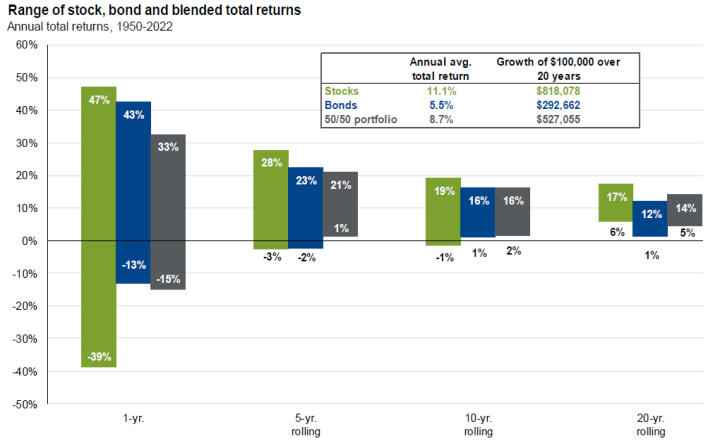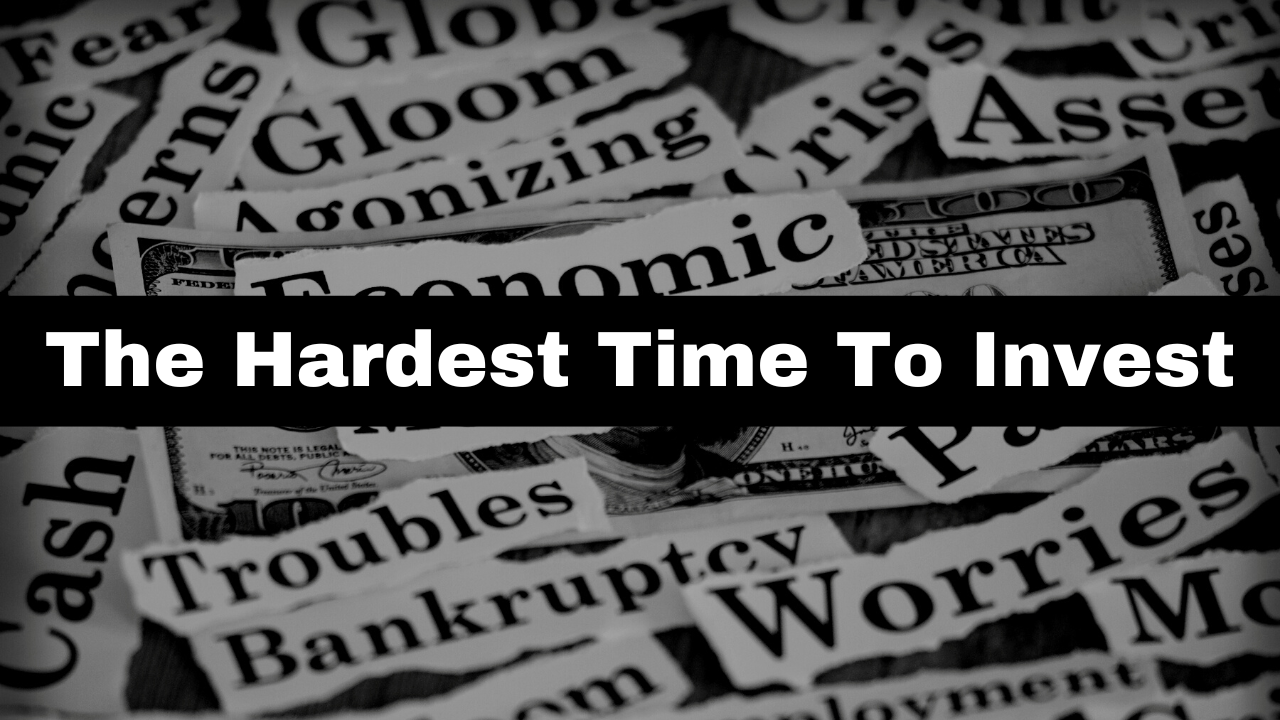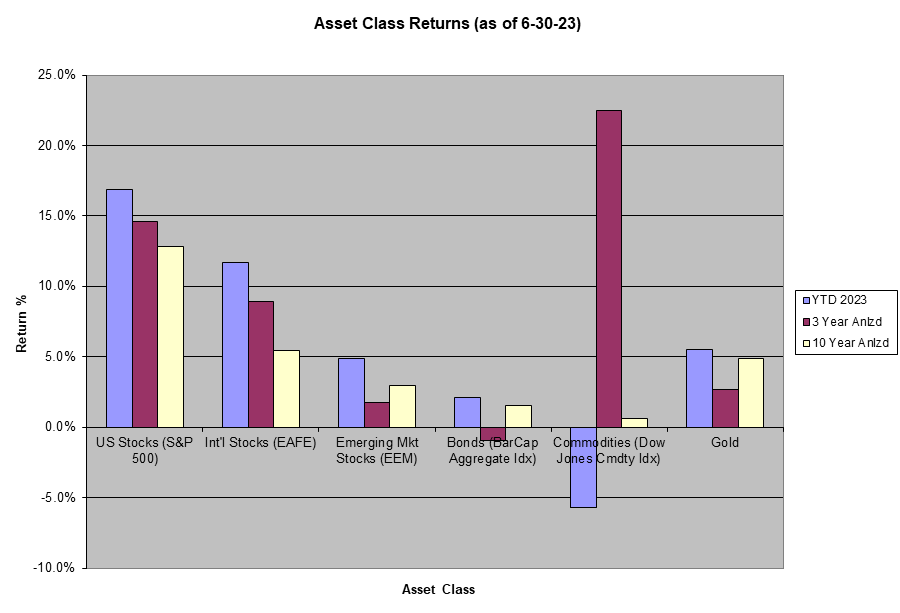The hardest time to invest is always now.
This statement might seem to be an exaggeration. Surely, there have been times in financial history when investing was more challenging? The dot-com crash, the financial crisis of 2008, and the market volatility spurred by the global pandemic come to mind. While those were undeniably difficult periods, the difficulty of investing now taps into a deeper truth about investing. The ‘now’—the present moment—always feels fraught with uncertainty.
We know what has happened in the past, and we can only guess what will happen in the future. But the present moment is where we make decisions that can affect our future financial well-being, and that responsibility can feel daunting.
Why Investing Now is Hard
Recent Market Fluctuations
Whether markets have recently gone up or down can have a large impact on investor sentiment with a seemingly “lose-lose” proposition. If markets have been doing well, investors might worry that they’re too late and that a correction is due. If markets have been performing poorly, investors might fear that they’ll lose money if they invest now. Poor performing markets are especially challenging as investors are reminded daily about how risky and dangerous investing is. Under these conditions, there is never a right time to invest.
Information Overload
In today’s digital age, investors have access to an unprecedented amount of information and analysis. While this can be beneficial, it can also lead to information overload and “paralysis by analysis”. This can make the decision to invest right now feel particularly difficult. There’s just too many reasons not to invest; inflation is too high, the fed is tightening, there is a war, our political leadership can’t seem to agree on anything, etc.
Emotional Bias
Humans are emotional creatures, and these emotions can significantly impact our decision-making process. The fear of loss often outweighs the potential for gain in our minds, a concept known as “loss aversion”. This can make investing feel especially hard in the present.
Comparison with the Past
It’s easy to look back at past investment opportunities with the benefit of hindsight and feel like investing now is harder. For instance, someone might look at the tech boom or the early stages of a bull market and think, “if only I had invested then.” Or they may think, “‘l’ll just wait for the next bear market and invest after a steep sell-off”. Of course, this rarely comes to pass as the steep-sell off provides ample reason to hold off investing further (see point number 1 above).
These challenges to investing in the present hold one thing in common –they all involve an investor grappling with an uncertain future. Whether it’s market performance, economic conditions, geopolitical events, or company-specific factors, uncertainty can make investing always seem particularly challenging in the present moment.
To combat these challenges to investing, it is instructive to go back to the basic definition of investing: Investing is the act of committing money or capital to an endeavor (such as a business, project, real estate, or financial instrument) with the expectation of obtaining an additional income or profit in the future. It involves the purchase of assets with the intent that those assets will generate returns over time, either in the form of income (like interest or dividends) and/or appreciation (an increase in the value of the asset).
It turns out that while now may be the hardest time to invest, it is also generally the best time to invest. That is because if investing is about generating returns on your assets over time then, all else being equal, the sooner you invest and the longer you invest, the greater your odds of generating those returns.

Source: Bloomberg, FactSet, Federal Reserve, Robert Shiller, Strategas/Ibbotson, J.P. Morgan Asset Management
Why Now Is the Best Time to Invest
Time in the market is more important than timing the market
It’s nearly impossible to consistently predict market highs and lows. Instead, the longer you have your money invested, the more time it has to grow. Each day you delay investing is a day that your money isn’t working for you.
The power of compounding
This is the process where the returns on your investment generate their own returns. Over time, this compounding effect can lead to exponential growth in your investments. The sooner you start investing, the more time your investments have to compound.
Historical market trends
While there are no guarantees in investing, historically the value of many types of investments, such as stocks and real estate, have tended to rise over the long term. So, starting to invest sooner rather than later allows you to take advantage of these potential long-term trends.
Counteracting inflation
Inflation gradually erodes the purchasing power of money over time. By investing, you can aim to grow your wealth at a rate that outpaces inflation.
It’s important to note that while “now” is generally a good time to start investing, every individual’s situation is different. Factors such as financial goals, risk tolerance, and investment time horizon should all be taken into account when deciding both when and where to invest your money.
2023 Mid-Year Review and Outlook
In 2022 markets had to adjust for a higher and more persistent inflation environment. Rising interest rates, a War in Europe, and a variety of other factors had increased the collective odds of a recession. So far 2023 has seen an unwinding of these concerns as inflation has been rapidly falling, the economy has so far adjusted well to higher interest rates, and the strong job market has supported a resilient U.S. consumer.
Looking forward in mid-year 2023, there remain risks on the horizon, including a possible government shut-down in early October, ongoing geo-political risks and, of course, the possibility of a recession. However, as we discuss later in this section, making portfolio management decisions based on forecasted outcomes, good or bad, is both challenging and generally counterproductive to long-term investment success.
Year to date through 6/30/23:
- Domestic stocks (S&P 500) increased 16.9%
- Developed international stocks (EAFE) increased 11.7%
- Emerging market stocks increased 4.9%
- Bonds (Bar Cap Aggregate) were up 2.1%
- Commodities (DJCI) were down -5.73%
- Gold increased 5.5%
We have updated our asset class return chart to reflect year-to-date returns through June, along with three and ten year annualized returns for the aforementioned asset classes.
At the start of this year, the “looming” recession was top of mind for most investors. This is not surprising given the 2022 bear market that saw the S&P 500 drop 18%, and “safe haven” bonds drop more than 14%. After a year of rising interest rates and falling stocks and bonds, it seemed clear to everyone that a recession must be near. In fact, by late August of last year, less than two months before the market bottomed, Nearly 72% of economists polled by the National Association of Business Economics expected the US to be in a recession by the middle of 2023 – i.e. right now. Well, the recession hasn’t arrived yet; though many strategists are just pushing back the arrival date.
It’s probably no surprise that human beings are bad at predictions. But what about markets? Doesn’t a bear market or steep sell-off like the one in 2022 predict a recession? In short no. Markets really aren’t good or bad at predicting anything. Instead, they are imperfect processors of all known information. So when information changes at the margin for better (worse) markets rise (fall) accordingly. At least, that is the theory espoused by the efficient market hypothesis. This is not helpful for those who are forecasters, since if all publicly known information is being already reflected by the markets, then they can’t use this information to make reliable forecasts or predictions about the market.
Luckily, successful investing does not require one to be a successful forecaster. A less challenging road is to accept that the future is unknowable, and to instead attempt to understand the present and invest accordingly.
In assessing present investment opportunities we consider several fundamental characteristics:
- Quality: Quality investments include companies with strong balance sheets, high returns on assets, equity and/or invested capital (i.e. strong profitability), and an identifiable competitive advantage or “moat”.
- Dividend Growth: Companies that pay dividends, and specifically have a history of growing their dividend are favored in our firm’s dividend growth strategy. Dividends provide a “bird in the hand” cash return to investors, and companies that increase/grow the dividend provide a pay raise to investors.
- Valuation or “Price Paid”: One of our firm’s core principles is “the price you pay determines your return”. Pay too high a price for any investment, and your expected future return will be low, all else being equal. Likewise, an investment bought at a “low” price relative to its underlying value, will provide a higher expected return.
Focusing on these fundamental characteristics will not allow you to avoid the next bear market, or mitigate all risk. But taken together, a portfolio constructed utilizing these characteristics should provide high odds of avoiding permanent capital impairment (losses), and for achieving a sound investment return over time.
Should you have any questions regarding your investment account(s) and personal financial plans, or if there have been any recent changes to your investment and/or retirement objectives, please contact our office. We can also provide you with a current copy of our SEC Form ADV Part 2, at your request.
As always, we thank you for entrusting AMM to help you achieve your investment and retirement objectives
Individual accounts will vary based on a client’s stated investment objectives, risk tolerance and time frame. We manage several different strategies, so not every client will have exposure to the securities, asset classes or investment strategies described above. In addition to growth and/or income oriented asset allocation strategies, we also manage more concentrated equity portfolios that generally carry a higher degree of risk and volatility. For qualified investors, we periodically recommend short-term first trust deed investments secured by real estate that pay monthly distributions. Let us know if you want to discuss your specific portfolio strategy in greater detail.




